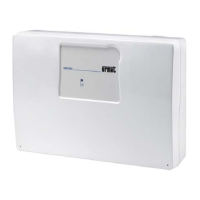DS1067-062C 77 LBT20063
7 TELEPHONE DIALLER
IMPORTANT! For the procedures contained in this chapter it is assumed that the 1067/024, 1067/032A or
1067/052A control panels are connected to at least one telephone network: PSTN via 1067/002A communicator
or GSM via 1067/458 module.
IMPORTANT! The control panel connection type determines EN50131 compliance.
A 1067/032A or 1067/052A control panel connected via the 1067/002A interface to an ATS4 external
communicator, connected in turn to a modem/router with ADSL line, is EN50131 grade 3 compliant.
A 1067/032A or 1067/052A control panel connected directly to a PSTN line via the 1067/002A, interface which
uses numeric protocols for alarm communications is EN50131 grade 2 compliant.
A 1067/024 control panel with PSTN connection integrated on the interface board is connected directly to a PSTN
telephone line which uses numeric protocols for alarm communications, is EN50131 grade 2 compliant.
All other telephone connections, including use of the GSM network via the 1067/458 interface, are not EN50131
compliant.
This chapter explains how:
• the telephone alarms work
• to add, edit or delete a telephone number
• to write or delete a text message.
7.1 ALARM MESSAGE SENDING SEQUENCE
In case of one or more alarm events, the dialler:
1) identifies the event with the highest priority if the events are different and simultaneous
2) calls the telephone number or numbers configured for the alarm event starting from the one with the lowest memory
position (e.g. T02 is called before T05)
3) the dialler make three attempts for each telephone number and calling mode
4) when several telephone numbers are programmed, a sequence is created to which the calls are sent alternatively to
the various numbers always respecting the event priority order. The called number sequence is dynamic and
depends on a case-by-case basis on the involved events and the concerned telephone numbers.
The vocal call cycle to be stopped by entering code "12" on the answering telephone after having listened to the
message and having received the block code prompt tone.
IMPORTANT! The text message sending sequence and the numeric protocol sending sequence cannot be
stopped.
For emergency vocal calls, the block code "12" can be entered after having closed the environmental listening session at
the end of the emergency vocal message repetition.
Vocal calls and text messages following burglar events may be interrupted also by disarming the zones assigned to the
telephone numbers programmed for sending the alarm. The function is useful in case of false alarms.
It is important to note that a telephone call cycle cannot be stopped once it has started and the system will continue to
call the given number until the end of the three attempts. No further calls will be made to any subsequent numbers
programmed for the burglar event.
The delivery time of SMS text messages depends on the GSM network company.
7.2 ANSWERING MACHINES AND CALL CYCLES
It is important to understand what will happen if an answering machine picks up the call.
If the “answer control” function is enabled in PSTN line parameters, the dialler may interpret the reply as a correctly
delivered alarm message and stop other calling attempts.
In this case, if the alarm sending mode is vocal only to a single telephone number, the recipient may not receive the
message or listen to it when it is too late (the same situation could occur if several telephone numbers are programmed
each of which provided with an answering machine, although this is less likely). In this case, it is advisable to deactivate
"answer control".

